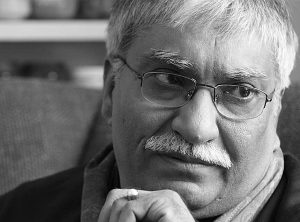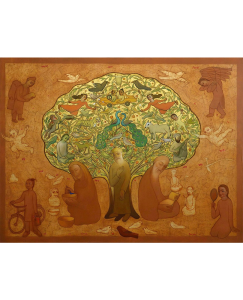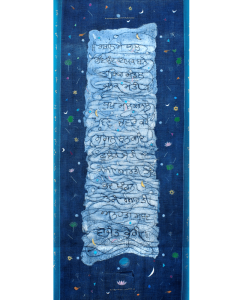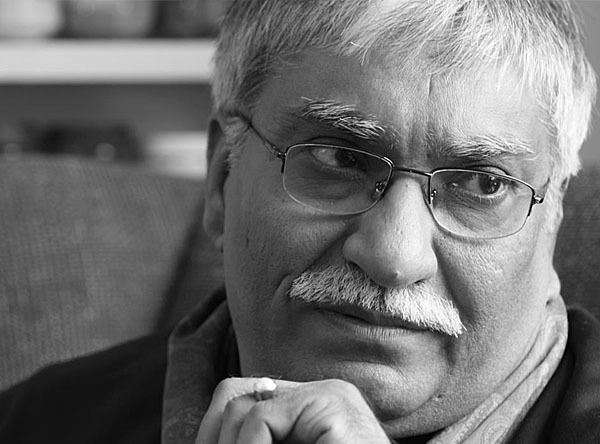Prachi Sahasrabudhe
From verses of Gurbani towards the path of nothingness:
‘Transcendence’ is a vital process that permits your true essence to blossom and take on a new form. It is all about awareness, which does not make you conscious that you are having it. Because you are unaware of your awareness, you can make decisions without hesitation. The pure thing in life is awareness disguised as ignorance. Believing in this idea, artist Sidharth had a transitory existence and narrates the dynamic events from his explorer’s life very eloquently in his artworks.

Sidharth was born to a Gurbani singing father and a mother who assisted villagers in dying their garments. He was taught at an early age that in this world, one does not need too many things, and that acquiring everything is the world’s motto. He discovered this at a young age. Listening to his father recite passages from the Guru Granth Sahib in his wonderful voice, he realised the significance and beauty of life. Sidharth developed a friendly demeanour as a result of his life experiences; he never said no to anything, and as a result, life always beckoned to him.
Sidharth, who was born in 1956 in Bassian, Punjab, received a diploma in painting from the Chandigarh College of Art. He works with both traditional and contemporary forms, visuals, and textures to tell his story, which is typically influenced by Indian folklore, classical literature, music, and poetry. His work is profound and impassioned, giving the viewer a unique spiritual encounter. He has won various awards and participated in numerous solo and group exhibitions both in India and abroad.
Sidharth is an artist whose narration skills evoke a soft sensation in the minds of his listeners. His life had been instinctual and organic, as he left his home not just to view the fields and oceans, but was taken away by the flow of life, which he believes was essential. He is an enchanted one who loves
nature so much that he finds everything charming and reinvigorating at every step. He rejects religions, claiming that he went through them as a young man, but to him art proven to be purer and more powerful than any other religion. He goes by the name Sidharth, which he acquired in the 1960s from a monastery in Dharamsala.

He is currently a successful Indian artist with regular clientele and customers. His New Delhi studio is spacious clean, and artistically set up, with a subtly placed invitation to take off shoes in the little entrance. Sidharth stores cutting-edge technology, including a projector, CD player, and woofer sound system, on a custom-made shelf in the reception area, which can also be used as a drawing or viewing room. On the opposite end of the room is a screen that may be accessible to see films, documentaries, and other visual content. Besides his artistic endeavour, Sidharth joined a group of Sufi musicians at a recording studio because he had always been inspired by the Gurbani vocalists of his generation. He disregarded every accepted definition of music, including hip-hop, blues, Buddhist chanting, and Gurbani. He was defying all the singing conventions since he leads an unconventional life. He thinks that nature’s laws and rules govern everything, and that personalities may be transcended but not entirely altered.

Siddharth is a well-travelled artist who collects unusual and custom-made brushes from his travels. He makes his own paints by grinding up natural herbs, stones, and other components. His studio assistants are knowledgeable in making pigments and can even recognise specific rocks and plants that might be sources of colour. To show the variety of tones he has achieved through the permutations and combinations of various paints, Siddharth has constructed colour charts and codes on each side of the shelves. His first encounter with natural pigments dates to his childhood, when he learned the value of being one with nature. During his childhood, he also learned mural and fresco methods from the village artist-master, Tara Mistry, who employed locally available colours found in nature. His fine hands proved an asset to Tara Mistry as he quickly learned the methods of mural and fresco.

https://www.gallerienvya.com/
In one of his works, Siddharth depicts the early years of his life. His mother, a pious-looking woman with sympathetic eyes, is depicted seated in the top right corner of the artwork. The painting’s centre has a lovely tree with fruits, birds, and two large peacocks. An elderly Sikh guy – his father may be seen singing Gurbani on the painting’s left side. Sidharth draws on the verses of the Guru Granth Sahib, which he can recite literally, as a source of inspiration, ideas, and intellectual clarity. The verses described the heroic lives of those who pursued poetry as a career and worked to protect nature. The sentiments for Sidharth’s parents, who formerly sat under this tree, are depicted in the picture.
His autobiographical series – “Thousand Hands and Feet”, is a visual depiction of his self-expression without his physical presence in the imagery. He never saw his parents again after a series of events brought him to Andretta and Macleod Ganj in Himachal Pradesh. Through depicting modest but meaningful acts of faith and love, this painting beautifully captures the pathos of Sidharth’s life. His
parents develop into visionaries and wise people, becoming a part of the universe where people only serve as a minor component while the devout shine like stars in the Milky Way. Siddharth embraces this painting and expresses that he would never sell it. Sidharth’s series of drawings depict ordinary people from his village who lived in accordance with the changing moods of nature and revered the Gurus. He remembers the cobbler reciting verses from the Guru Granth Sahib, a young man who turned to drugs and became a vagabond, and those horrific times when motorcycles carried men carrying AK-47 rifles into the villages, shooting people at random and leaving many dead and injured.
Sidharth is also a calligrapher who creates poetry and performs blues and joy songs. He is believed to be a spiritual painter whose works are populated by droopy-eyed levitating beings. There is a myth surrounding him due to his aloofness, but he has a complex personality and an interest in everything.
Sidharth might have followed in his father’s footsteps and became a Gurbani singer, but he was aware of the sacrifices required for such a life of sacrifice and commitment. He wonders how his father managed to isolate himself from his family and become so content to write poetry and sing. He considers his father’s example and often questions how he could find comfort in his songs and lyrics, despite of receiving inadequate wages for his art. But his father seemed at peace, and he had the impression that he had been taken to another plane of life. Siddharth compared his mother to Madonna, who could hold them all in her arms, gaze serenely into their eyes, and comfort them in ways beyond words. Siddharth’s mother was fearful of the state law after witnessing the Indo-Pakistani partition and wanted her son to leave the region. He was transited from the village to protect him from being picked up by the police. On his departure day, his father sung poems from the Guru Granth Sahib while his mother was shedding joyful tears. However, Siddharth was worried about leaving his mother behind and encountering new people outside of his town in a foreign land. His journey was altered by the way life had taken him.

Sidharth left his hometown and made his way to Andretta, where he came across the veteran painter Shobha Singh. Given that he gave the Hindu gods and goddesses faces and distinguishing physical traits, Shobha Singh was a beloved person in the Sikh faith. He created the Sikh Guru portraits and established the standards and guidelines for all Sikh artists to follow while creating the portraits. Sidharth was recommended to travel to Andretta to complete an apprenticeship under Shobha Singh because, after learning the master’s portraiture methods, Sidharth would be able to make a career in any location in the world.
Shobha Singh was more feared than respected, as Siddharth freely confesses. As the days went by, Sidharth began studying academic and stylized portraiture approaches, which he found enjoyable. He was still lugging around a lot of the memories from his previous life. Andretta was a short distance from Macleod Ganj. Popular local personality Shobha Singh frequently welcomed religious experts from various backgrounds to his studio. Shobha Singh’s close friend, Dorji from the Tibetan Buddhist
Monastery, paid a weekly visit to the studio. Sidharth preferred Dorji over his tutor, Shobha Singh, since he admired Dorji. Sidharth was growing dissatisfied and wanted to escape to a new and unexplored realm. His mind was always racing, and he was constantly worried. Sidharth believed Dorji was his saviour. Once Dorji grinned at him and questioned why he had not tried to get to know Buddha better. Upon this question, Siddharth was caught in the gusts from the hills and shaken like a bamboo stalk. Soon, He concluded that it was time to leave Andretta and follow the Buddha’s path of enlightenment. And with that, Harjinder Singh departed Andretta without telling anybody, on his journey to becoming “Sidharth,” where he found himself seated at the Buddhas’ feet.
References:
- ML, Johnny, “The circle of Light – Life and times of Siddharth,” Chennai, Prakrit Arts pvt.ltd., p.p. 1 to 15.
- ML, Johnny, ‘By all means necessary’, July 2011, JohnyML. blogspot.com. • https://www.gallerienvya.com/artist/sidharth/





